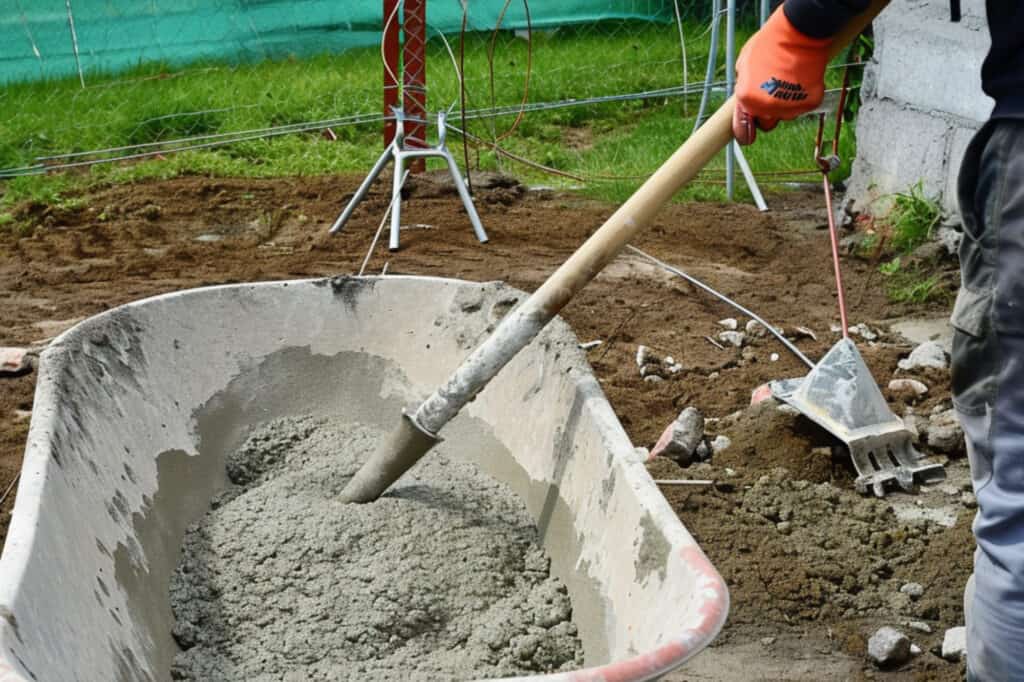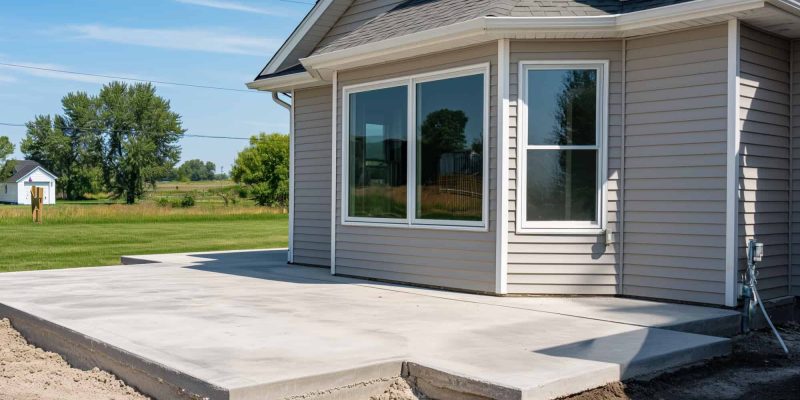Are you looking to transform your backyard with a beautiful concrete patio? You’ve come to the right place! We’ve got an easy-to-follow guide that will take you through every step of creating your own concrete paradise. Let’s dive in and make your patio dreams a reality.
Understanding the Basics
A concrete patio is a fantastic addition to any Rockford home. It’s a flat, hard surface made of—you guessed it—concrete, and it’s perfect for everything from family barbecues to sunbathing. But why choose concrete? Well, it’s super strong, lasts for years, and doesn’t need much care. Plus, it’s usually more budget-friendly than other materials like bricks or stone.
For this project, you’ll need some basic tools and materials. Think of things like a shovel for digging, a rake for leveling, wood for making frames, and of course, concrete mix. You don’t need to be a construction pro – just willing to get a bit dirty!
Preparing for Your DIY Concrete Patio
The success of your patio project hinges on thorough preparation, which involves several key considerations. First, the choice of location is crucial. Think about how the sun hits your yard throughout the day, how close the patio will be to your home, and what you plan to use the space for. The right spot can enhance your comfort and reduce maintenance efforts down the line.
Next, consider the size of your patio. This should directly reflect what you intend to use it for. A cozy, small area might be just right for a quiet morning coffee spot or a bistro set, while you might need a larger space for hosting family gatherings or setting up a fire pit. Keep in mind that the larger your patio, the more materials and labor you will need, which can impact your budget and timeline.
In Rockford, it’s also important to navigate local regulations regarding construction. Some projects might require permits, so it’s wise to contact your local building department. They can provide information on the necessary requirements and help ensure your project is in line with local codes.
Another critical step is identifying any underground utilities in your yard. Accidentally hitting a utility line during construction can be dangerous and lead to expensive repairs. In Illinois, you can dial 811 to connect with JULIE, the Illinois One-Call System. They offer a free service to locate and mark underground utilities, ensuring you can dig safely and confidently.
Finally, creating a detailed design plan for your patio is an essential step. Sketch out how you envision your patio, including its dimensions and any unique features like steps, borders, or decorative elements. This plan will not only serve as a guide during construction but also helps in accurately estimating the amount of materials you’ll need. A well-drafted design plan is like a roadmap that navigates you through the construction process, ensuring that every step is measured and executed correctly.
Gathering Your Materials and Tools
Now, let’s talk about what you’ll need to bring your patio to life. Gathering the right materials and tools beforehand will make your project go smoothly.
- Concrete Mix: The heart of your patio. The amount needed depends on the size and thickness of your patio. As a general rule, a 60-pound bag of concrete mix covers about 0.45 cubic feet. So, for a 10×10 foot patio at 4 inches thick, you’ll need about 100 bags. If in doubt, consult with your local hardware store in Rockford, where experts can help calculate the exact amount based on your patio dimensions.
- Gravel: This forms the base layer of your patio and aids in drainage, preventing water from pooling on your concrete surface. A layer of 4 to 6 inches is typically sufficient.
- Lumber: Used to create forms that will shape and contain your concrete. These can be made from 2×4 or 2×6 boards, depending on the desired thickness of your patio.
- Shovel and Rake: For excavation and spreading gravel.
- Tamper: A must-have for compacting the gravel and soil, ensuring a stable base.
- Wheelbarrow: Ideal for mixing smaller batches of concrete and transporting materials.
- Level: Crucial for ensuring your forms are set correctly and your surface is even.
- Concrete Float and Trowel: For smoothing and finishing the concrete surface.
- Measuring Tape and Carpenter’s Square: For accurate measurements and angles.
- Screed: A straight edge used to level the concrete after it’s poured.
TIP
Remember, the amount of each material depends on your patio size. A local hardware store can help you figure out how much you’ll need.
Setting the Stage: Site Preparation
Now that you have all your materials and tools, it’s time to prepare the site for your new patio. This step is crucial for a long-lasting and stable patio.
- Marking the Area: Use stakes and string to outline the exact shape and size of your patio. This visual guide will help you during excavation and when setting up your forms.
- Clearing the Site: Remove any grass, plants, roots, rocks, and debris. The goal is to reach bare earth. If there are any significant dips or hills, you’ll need to level the area as much as possible.
- Digging the Base: Depending on your patio design, you’ll need to dig down several inches – generally, the depth should be the thickness of your gravel base plus the thickness of your concrete. For example, a 4-inch gravel base plus a 4-inch concrete layer means digging 8 inches deep. Use your shovel for digging and the rake for leveling.
- Adding and Compacting Gravel: Spread the gravel evenly across the dug-out area. This layer provides a stable foundation and improves drainage beneath the concrete. Once laid, use your tamper to compact the gravel firmly, ensuring a solid base. Aim for a consistent layer throughout the entire area.
- Setting Up Forms: Using the lumber, construct a perimeter frame around your patio area. This will hold the concrete in place as it dries. Make sure the top of the forms are level – this will define the surface level of your patio. Secure the forms in place with wooden stakes and use your level to ensure they are perfectly horizontal.
- Double-Checking Measurements: Before moving on, re-measure your forms to ensure the patio dimensions are accurate according to your design plan. This is also a good time to make any final adjustments to the layout.
Mixing and Pouring the Concrete

This is where the magic happens! Mixing concrete might seem intimidating, but it’s quite straightforward. Here’s how to do it right:
- Mixing the Concrete: If you’re working on a smaller patio, you can mix your concrete in a wheelbarrow using a shovel. For larger patios, consider renting a portable cement mixer. Add water to the concrete mix gradually, aiming for a consistency that is thick and moldable, not runny. It should hold its shape when squeezed. Mix thoroughly to eliminate any dry pockets.
- Pouring the Concrete: Start at the farthest corner from where you’ll be working. Slowly pour the concrete into the forms, filling them to the top. Use your shovel or rake to spread the concrete, ensuring it gets into all corners and edges. Be careful not to over fill the forms. Consistency is key here; aim for a level and uniform layer across the entire area.
- Leveling the Surface: Once the forms are filled, use a screed (a long, straight 2×4 works well) to level the concrete. Move the screed back and forth across the surface in a sawing motion, floating it over the top of the forms. This process removes excess concrete and levels the surface.
- Smoothing with a Float: After screeding, the surface will still have some imperfections. Use a concrete float to smooth these out. Glide the float over the surface in sweeping arcs, pressing just enough to smooth the concrete without pushing it down. This step is crucial for achieving a flat, even patio surface.
- Creating Edges and Joints: While the concrete is still soft, use an edging tool to shape and define the patio’s edges. This not only enhances the appearance but also helps prevent chipping and cracking. If your patio is large, you’ll also want to create control joints. These are shallow cuts in the concrete that control the location of cracking as the concrete expands and contracts. A jointer or a straight piece of lumber can be used for this purpose.
Finishing Touches: Smoothing and Curing
After pouring and smoothing your concrete, the next step is finishing. This is crucial for both the look and durability of your patio.
- Texturing for Traction: Once you’ve finished smoothing, you may want to texture the surface for slip resistance, especially important in wet or icy conditions. Gently dragging a push broom over the wet concrete creates a textured, non-slip surface.
- Curing the Concrete: Concrete takes time to reach its full strength. For the first 48 hours, avoid walking on it. Keep the surface moist by lightly spraying it with water several times a day for at least a week. This process, known as curing, is vital for preventing cracks and ensuring a strong and durable patio.
- Removing the Forms: After about 48 hours, you can carefully remove the wooden forms. Do this slowly to avoid damaging the edges of your new patio.
- Sealing for Longevity: Once fully cured, consider applying a concrete sealer. This will protect your patio from moisture, stains, and weather damage, and can also enhance the color and finish of the concrete.
NOTE
Your patience and attention to detail during these final steps will greatly influence the quality and longevity of your patio. With proper finishing and curing, your concrete patio will be a beautiful and durable addition to your Rockford home.
DIY Pitfalls to Avoid
Even with careful planning and execution, there are common pitfalls that can derail your patio project. Being aware of these can save you time, money, and frustration:
- Incorrect Measurements: One of the most common mistakes is miscalculating the size of the patio or the amount of materials needed. Double-check your measurements before purchasing supplies. It’s better to have a little extra than to run short midway through your project.
- Ignoring Weather Conditions: Concrete is sensitive to weather. Pouring concrete on a very hot day can cause it to dry too quickly, while cold or rainy weather can hinder its curing process. Choose a day with mild, dry weather for your project.
- Inadequate Base Preparation: Skimping on site preparation can lead to an unstable and uneven patio. Make sure the ground is properly leveled and compacted, and the gravel base is sufficient. This is crucial for long-term durability.
- Poor Concrete Mixing: Incorrectly mixed concrete can weaken your patio. Follow the instructions for your specific concrete mix, and aim for a uniform consistency. Avoid adding too much water, which can dilute the mix and reduce its strength.
- Rushing the Process: Patience is key when working with concrete. Rushing through the mixing, pouring, or curing stages can result in a poorly finished product. Allow ample time for each step, especially curing, to ensure the best outcome and avoid concrete patio repairs.
- Overworking the Concrete: Once poured, it’s important to smooth and finish the concrete efficiently. Overworking the surface can bring too much water to the top, weakening the concrete and leading to problems like scaling and cracking.
- Neglecting Control Joints: For larger patios, control joints are essential to manage cracking as the concrete expands and contracts. Failing to create these joints can result in unsightly and uncontrolled cracking across your patio.
Conclusion
Congratulations! You’re now equipped with the knowledge to pour your concrete patio. With a bit of planning, the right materials, and a willingness to get your hands dirty, you can create a beautiful outdoor space for your home. Remember to take your time, pay attention to details, and most importantly, enjoy the process of bringing your patio vision to life. Good luck, and here’s to many wonderful days spent on your new concrete patio!

